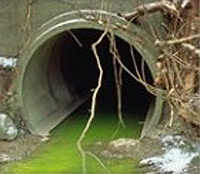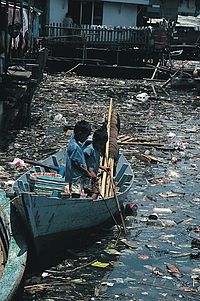High School Earth Science/Water Pollution
Freshwater and ocean pollution are serious global problems that affect the availability of safe drinking water, human health, and the environment. Waterborne diseases from water pollution kill millions of people in undeveloped countries every year. Agricultural uses: no matter a nation's income, most freshwater is used for agriculture. About 1500 liters (400 gallons) of water is needed to produce just one kilogram (2.2 pounds) of wheat. About 15,000 liters (3962.5808 gallons) of water is needed to produce just one kilogram of grain-fed beef.
Lesson Objectives
[edit | edit source]- Discuss the risks that water pollution poses to human and environmental health.
- Explain where fresh and saltwater pollution come from.
- Discuss how pathogen born diseases are caused by water pollution.
- Describe why conserving water and protecting water quality is important to human health and the environment.
- Describe how water pollution reduces the amount of safe drinking water available.
- Discuss who is responsible for preventing and cleaning up water pollution.
Sources of Water Pollution
[edit | edit source]Water pollution can make our current water shortages even worse than they already are. Imagine that all of your drinking water came from a river polluted by industrial waste and sewage. In undeveloped countries throughout the world, raw sewage is dumped into the same water that undeveloped people drink and bathe in. Without the technology to collect, treat and distribute water, people do not have access to safe drinking water. Throughout the world, more than 14,000 people die every day from waterborne diseases, like cholera which is spread through polluted water.
Even in developed countries that can afford the technology to treat water, water pollution affects human and environmental health.
Water pollution includes any contaminant that gets into lakes, streams, and oceans. The most widespread source of water contamination in undeveloped countries is raw sewage dumped into lakes, rivers and streams. In developed countries, the three main sources of water pollution are:
- Agriculture, including fertilizers, animal waste and other waste, pesticides, etc.
- Industry, including toxic and nontoxic chemicals
- Municipal uses, including yard and human waste
Types of Water Pollution
[edit | edit source]Municipal Pollution
[edit | edit source]
Wastewater usually contains many different contaminants. This makes it difficult for the Environmental Protection Agency (EPA) to identify the main source when toxic chemicals are found in wastewater. The pollution coming from homes, stores and other businesses is called municipal pollution (Figure 21.16). Contaminants come from:
- Sewage disposal (some sewage is inadequately treated or untreated)
- Storm drains
- Septic tanks: sewage from homes
- Boats that dump sewage
- Yard runoff (See agriculture discussion of fertilizer waste)
Industrial Pollution
[edit | edit source]Many kinds of pollutants from factories and hospitals end up in our air and waterways (Figure 21.17). Some of the most hazardous industrial pollutants include:
- Radioactive substances from nuclear power plants, as well as medical and scientific uses.
- Other chemicals in industrial waste, such as heavy metals, organic toxins, oils, and solids.
- Chemical waste from burning high sulfur fossil fuels that cause acid rain.
- Inadequately treated or untreated sewage and solid wastes from inappropriate waste disposal.
- Oil and other petroleum products from supertanker spills and offshore drilling accidents.
- Heated water from industrial processes such as power stations.

Agricultural Pollution
[edit | edit source]Agriculture includes crops, livestock, and poultry farming. Most agricultural contaminants are carried by runoff that carries fertilizers, pesticides, and animal waste into nearby waterways (Figure 21.18). Soil and silt erosion also contribute to surface water contamination.

Animal wastes expose humans and the environment to some of the most harmful disease causing organisms or pathogens. These include bacteria, viruses, protozoa, and parasites. Pathogens are especially harmful to humans, because they can cause many illnesses including typhoid and dysentery as well as minor respiratory and skin diseases.
You may be surprised to learn that even the fertilizers we use on our lawns and farm fields are extremely harmful to the environment. Fertilizers from lawns and farm fields wash into nearby rivers, lakes and the oceans. Fertilizers contain nitrates that promote tremendous plant growth in the water. Consequences of this accelerated plant growth include:
- Lakes, rivers, and bays become clogged with a carpet of aquatic plants that block light from entering the water.
- Without light reaching plants in the water below, these organisms die.
- As the plants die, their decomposition uses up all the oxygen in the water. Without enough dissolved oxygen in the water, large numbers of plants, fish and bottom-dwelling animals die.
Every year you can see dead zones, hundreds of kilometers of ocean without fish or plant life (Figure 21.19). These dead zones occur in the Gulf of Mexico and other river delta areas due to water polluted with fertilizers. In 1999, a dead zone in the Gulf of Mexico reached over 7,700 square miles.

Ocean Water Pollution
[edit | edit source]
Most (80%) of ocean pollution comes as runoff from agriculture, industry, and domestic uses (Figure 21.20). These same kinds of runoff also pollute freshwater. The remaining 20% of water pollution comes from oil spills and people dumping sewage directly into the water.
Coastal pollution can make coastal water unsafe for humans and wildlife. After rainfall, there can be enough runoff pollution that beaches are closed to prevent the spread of disease from pollutants.
A large proportion of the fish stocks we rely on for food live in the coastal wetlands. Coastal runoff from farm waste often carries water-borne organisms that cause lesions that kill fish. Humans who come in contact with polluted waters and affected fish can also experience harmful symptoms. More than one-third of the shellfish-growing waters of the United States are adversely affected by coastal pollution.
Thermal Water Pollution
[edit | edit source]Thermal pollution is anything that causes water temperatures to rise or fall (Figure 21.21). For example, power plants and other industries often use water to cool equipment. Once the water absorbs heat from a power plant or industry, the heated water is returned to the natural environment at a higher temperature. Cold water pollution can be observed when very cold water is released from reservoirs.

Why would changing water temperature harm the environment? Fish and other aquatic organisms are often vulnerable to even small temperature changes. Heated water kills fish and other organisms by decreasing oxygen supply in the water. Frigid water has a severe effect on fish (particularly eggs and larvae), macro invertebrates and river productivity.
Lesson Summary
[edit | edit source]Industrial, agricultural, and municipal sources produce harmful water pollutants such as toxic chemicals, radiological agents, and animal wastes. Thousands of people die from waterborne diseases every year.
Review Questions
[edit | edit source]- What do the initials "EPA" stand for?
- What is runoff and why is it a problem?
- Who is responsible for reducing water pollution?
- Explain what a dead zone is and where you might find one?
- What is the leading cause of death for children around the world?
Vocabulary
[edit | edit source]- dead zone
- A region hundreds of kilometers wide without fish or plant life due to lack of oxygen in the water.
- thermal pollution
- Water pollution created by added heat to water.
Points to Consider
[edit | edit source]- Water pollution not only harms human health and the environment. Consider how this reduces the amount of water available to humans.
- Fifty percent of all infectious diseases are caused by water pollution. What can be done to reduce the number of pathogens that reach our freshwater supplies?
- Ocean pollution harms some of the most productive sources of marine life. How can we change our behaviors to protect marine life?